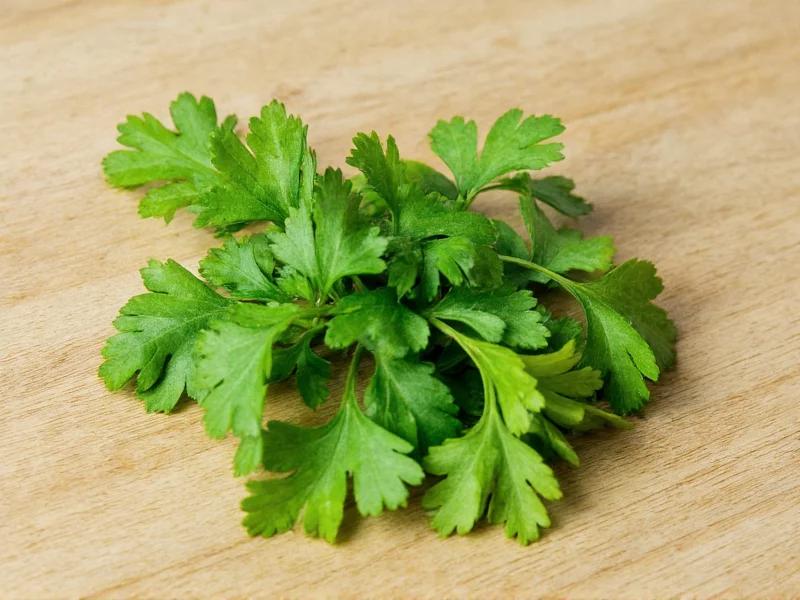The standard conversion ratio is 1 teaspoon of dried cilantro equals 1 tablespoon of fresh cilantro. This 1:3 measurement ratio accounts for the concentrated flavor of dried herbs compared to their fresh counterparts, making it essential for accurate recipe substitution.
When working with cilantro in your kitchen, understanding the proper dried cilantro to fresh conversion can make the difference between a perfectly seasoned dish and one that falls flat. Many home cooks face this dilemma when their recipe calls for fresh cilantro but they only have dried on hand, or vice versa. Getting this substitution right matters because cilantro's distinctive flavor plays a crucial role in many Mexican, Indian, and Southeast Asian dishes.
Understanding the Dried Cilantro to Fresh Conversion Ratio
The fundamental rule for dried cilantro to fresh substitution follows the general herb conversion principle: dried herbs are typically three times more potent than their fresh counterparts. This concentration occurs because the drying process removes moisture while preserving and intensifying the essential oils responsible for flavor.
For precise measurements:
| Dried Cilantro | Fresh Cilantro Equivalent |
|---|---|
| ¼ teaspoon | ¾ teaspoon chopped |
| ½ teaspoon | 1½ teaspoons chopped |
| 1 teaspoon | 1 tablespoon chopped |
| 1 tablespoon | 3 tablespoons chopped |
Flavor Profile Differences Between Dried and Fresh Cilantro
While the dried cilantro to fresh conversion ratio provides the mathematical substitution, understanding flavor differences is equally important. Fresh cilantro offers a bright, citrusy, slightly peppery flavor with grassy notes that many describe as "soapy" (a genetic predisposition affecting about 20% of people). Dried cilantro, however, develops a more earthy, muted flavor profile with diminished citrus notes.
When substituting dried for fresh cilantro to fresh in recipes, consider these flavor implications:
- Dried cilantro works better in long-cooked dishes like stews, soups, and braises where its flavor can gradually infuse the dish
- Fresh cilantro's delicate flavor shines in finishing dishes like salsas, guacamole, and garnishes
- Dried cilantro lacks the vibrant green color of fresh, which affects presentation
- The distinctive "fresh" aroma of cilantro diminishes significantly when dried
When Substitutions Work Best: Practical Cooking Guidance
Not all recipes tolerate dried cilantro to fresh substitutions equally well. Understanding which dishes accommodate this swap prevents culinary disappointment. For optimal results with dried cilantro instead of fresh, follow these practical guidelines:
Dishes Where Dried Cilantro Works Well
- Slow-cooked recipes: Chili, stews, and curries benefit from dried cilantro added early in cooking
- Dry rubs and spice blends: Dried cilantro integrates seamlessly into seasoning mixes
- Canned or preserved foods: The flavor holds up better in preserved applications
- Hearty bean dishes: Black beans, refried beans, and lentil preparations
Dishes Where Fresh Cilantro Is Essential
- Fresh salsas and pico de gallo: Dried cilantro cannot replicate the texture and bright finish
- Garnishes: The visual appeal and fresh aroma matter significantly
- Ceviche and raw fish preparations: Fresh cilantro's enzymatic properties matter
- Cilantro-lime rice: The citrusy notes need fresh expression
Maximizing Flavor When Substituting Dried for Fresh Cilantro
When you must use dried cilantro instead of fresh in recipes, these professional techniques help bridge the flavor gap:
- Bloom in oil: Heat 1 teaspoon dried cilantro in 1 tablespoon oil for 30 seconds before adding to dishes
- Rehydrate: Mix dried cilantro with equal parts warm water and let sit for 10 minutes
- Combine with acid: Add a squeeze of lime juice to revive some citrus notes
- Add early: Incorporate dried cilantro at the beginning of cooking to allow flavor development
- Boost with complementary herbs: Add a pinch of cumin or oregano to enhance earthiness
Storage Considerations for Both Forms
Proper storage affects the potency of both dried and fresh cilantro, directly impacting your dried cilantro to fresh conversion accuracy:
Fresh cilantro: Store stems in water like flowers, covered with a plastic bag in the refrigerator. Properly stored, it lasts 7-10 days. For longer storage, chop and freeze in ice cube trays with water or oil.
Dried cilantro: Keep in an airtight container away from light and heat. Properly stored, it maintains good flavor for 1-2 years, though potency gradually diminishes. Test older dried cilantro by rubbing a small amount between your fingers—if the aroma is weak, you may need to slightly increase the amount used.
Common Questions About Cilantro Substitution
Many home cooks have specific concerns when considering dried cilantro to fresh conversion in their recipes. Understanding these nuances helps achieve better results in your cooking.











 浙公网安备
33010002000092号
浙公网安备
33010002000092号 浙B2-20120091-4
浙B2-20120091-4